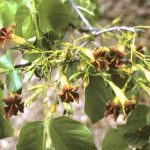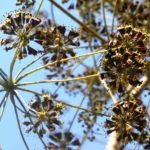TREE LIFE
AUGUST 1993
MASHONALAND CALENDAR
Saturday 7th August : Botanic Garden Walk at 1045 hours for 1100 hours. Park at the Herbarium where we’ll meet Tom Muller.
Sunday 15th August : A riverine venue is our choice for August and this month we have the added interest of Dyke endemics when we revisit the Caesar Pass. On a previous trip nearly 6 years ego, we saw Olax dissitiflora, Rapanea melanophloeos, Phoenix reclinata, Ozoroa longipetiolata, Securidaca longipedunculata, and many other species. Mr Rod Petzer, manager of the Caesar Mine, is very kindly providing tea at 9.00 at the Barwick Club where we hope to meet some local enthusiasts who are keen to join us. We will then proceed to the Pass nearby, for the rest of the day.
Saturday 28th August: No Botany walk this month.
Tuesday 7th September : Botanic Garden Walk
MATABELELAND CALENDAR
Saturday 1st August : A visit to some of Bulawayo’s historic trees. Meet at Girls‘ College for an 0830 hour departure. The round trip will be less than 35 Kms. Return to Girls‘ College where tea will be provided, bring your own eats and chairs.
Monday 9th August : Urban Trails – Hillside Dams at 1645 hours for 1700 hours
Sunday 5th September : To Imadzi and Gulati for a morning walk in the Matopos. It will be an 80 Km trip all told, bring a portable tea and we hope you will be back home for lunch or perhaps you would like to picnic in the Matopos.
Monday 13th September : Urban Trails
Sunday 3rd October : To Mabukuweni
AN UNUSUAL START TO JULY (For Bulawayo)
We were to go to Nata and Plumtree with Derek Viljoen to see the wonderful aloes and their many hybrids that grow so profusely in that area. But planned events were rapidly overtaken by the elements. At about 10 o’clock on Thursday the first stratiform clouds raised their dismal heads over the horizon and a low grey curtain was drawn across the sky for the next five days. Temperatures hovered around 12°C the cold south-easter swept in rain and drizzle (l4mm over the guti period) and thoughts as well as hearts turned indoors to home and hearth. Many people phoned to say they would not be coming along, so very reluctantly we cancelled the trip.
GUITINGWOOD REVISITED : JUNE 20 1993
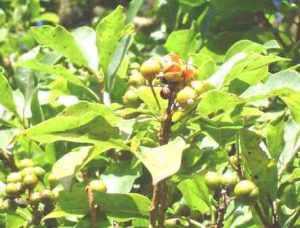
Pittosporum viridiflorum. Photo: Bart Wursten. Source: Flora of Zimbabwe
No dazzling display of water lilies greeted us this time as we are two months into winter -but General Purshing saved the day. This is one of the most popular American hybrids for various reasons, two of which are that it opens early and closes late; one of the fat buds opened in the midday sun and looking at the lovely pointed mauve pink petals one can see why it is so popular. At the entrance to the inner garden a Pittosporum viridiflorum laden with colourful seed blatantly advertised Cottrill’s ‘woodlot’ – and what a “woodlot’ it is! Such a glorious area of giant sized and pint sized rocks and trees; ideal backdrops to the lovely Commiphora marlothii with last year’s gold and brown bark peeling away from this year’s bright green stem and to splashes of the red Pterolobium stellatum and so MUCH MORE. John explained that he had planned his park in two sections – he had decided to leave the one-half completely natural and in the other half he was planting ‘showy’ trees, i.e. ones with colourful flowers and fruits to enhance its natural beauty.
Kim, on our last visit had identified almost all the trees and John had labelled them meticulously and as Phil and Cheryl had written a full article on them (see Tree Life 135, March 1991) we were so lucky in that we now had time to more closely study the trees and listen to Phil’s anecdotes (they help to remember the trees). John had during the year observed his trees and taken photographs of them in full flower and had more or less selected those he wished us to see. It was so much more interesting in that in the winter we have to rely more on identification of bark and not foliage so much – and what better one to start with than a completely leafless Lannea discolor – we just had to look at the big fat fingertips. And what about the Terminalia stenostachya – here Phil identified the bark as “anastomosing” (definition, anastomosis is a cross connection of arteries, branches, rivers, etc.) and on consulting Piet van Wyk’s book on “The Trees of the Kruger National Park” it seems that other species of Terminalia have much the same sort of bark. The photographs in this hand book are very clear and most helpful and show the great differences one finds in the bark of different species of trees and indeed on trees within the same genera. Take for instance the Ochnas; and here interestingly we find another type of bark in Ochna schweinfurthiana so common here, where the bark is “tessellated” (copious square segments from the word “tesserae”, small blocks used in mosaics. So very different from Ochna pulchra (Phil’s mermaid tree) the bark of which peels to reveal a beautiful creamy opalescent under bark.
Surprise, surprise – do you remember what was said about the family CAPPARACEAE (caper family) in that the mustard oils in the leaves should protect a plant in this family against leaf eating insects. The Maerua triphylla looked tattered and torn the way its leaves had been eaten by some caterpillar/moth or beetle, obviously immune to mustard. And it is good for babies too, as evidenced by the many tiny pupae hanging on gossamer threads from the leaves. We could not pass the Pericopsis angolensis without checking to see if there really was a dead black branch on the left hand side of the tree and sure enough; it was there. John showed us how the Pericopsis (muwanga) bark had been heavily browsed by the goats, so he sold the goats to save the ‘trees! But as Phil pointed out the trees had not been ring-barked and thus would survive. The RUBIACEAE family are well represented in John’s park and he showed us a photograph of Pavetta schumanniana (poison pavetta) in full flower in January of this year and it was quite spectacular. Another interesting member of this family Tricalysia angolensis (re-named niamniamensis) always seems to be in bud in the axils of its leaves but does not seem to flower, although reference books describe the flower.
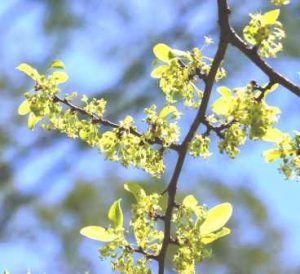
Margaritaria discoidea. Photo: Bart Wursten. Source: Flora of Zimbabwe
The spotted dogs wandered round with us and we came to their favourite tree, Vitex payos, a beautiful large tree with attractive palmate (or digitate) leaves. The dogs relish the chocolate berries this tree scatters around when in fruit; John had thoughtfully pickled some in vinegar for us to taste, not quite like the fresh ones! This tree had another type of bark, “striated” (deep vertically fissured). Margaritaria discoidea (the pheasant berry) displayed a wealth of green leaves on the surface, but lift a leaf up and lo and behold there is a cluster of small berries tucked underneath – another of nature‘s protective ruses? Phil showed us how the leaflets of the Afzelia quanzensis (pod mahogany) had a pale yellow margin and from now on it will be known as the tree with the ‘gilt trimming’.
We were not allowed to stop to admire the Sterculia quinqueloba in this area, as John was saving the pride of the park for last – and what a sight it is. No flowers or fruit this time but greens and gold and yellows of falling leaves and a broad expanse of orange brown carpet and the bark, cream to pinkish brown; as if Lilian had been at work with her pastels. Surely this tree does not deserve Phil’s easy to remember name of “peculiar stinkallover”.
It was now lunch time and back to the house for a few mimutes chat with our hosts and a quick look at John’s Moringa oleifera (see Tree Life No. 150 August 1992). It is only about two metres and not a leaf in sight, but a mass of tiny white/cream flowers and we disturbed a medium sized beetle very busy taking nectar from the tiny flowers – or was it pollinating them? I doubt whether there is another such tree within flying range, but perhaps it is monoecious (male and female flowers separate but borne on the same plant) or bisexual (both sexes in the same flower).
Do dreams come true — sometimes they do. During the second world war John was stationed in Manipur State between India and Burma and on his trips for the first time in his Life saw the wild water lilies flourishing in the ditches along the sides of the roads. He found them so attractive that when he came to this country he tried to buy local water lilies from the nurseries but was not very successful – until he was referred to Brian Terry, whose garden is quite a legend in Harare. Brian also introduced him to Koi fish and gave him pamphlets on American water lily nurseries from which he obtains many of his lovely plants. The fish and water- lilies seem to go together – the fish need the large leaves to shelter under in the hot sun and the stems make an ideal playground to swim in and out all day long.
A dream come true and a story as charming as the sweet perfume of John’s water lilies.
Phil has told you that Lilian is a bird artist and so she is – but at least ten years ago l purchased from one of the local organisations a set of prints of countryside paintings which now hang in my office, msasa trees, tumbles of rocks, African huts and blue mountains and water, the countryside as we all know it. That was before birds became her love and also because there is such a demand for bird paintings. These paintings do, however, entail a lot of prior observation work by means of watching them in her garden or taking photographs and so on.
She had a short respite when she underwent a cataract operation, fortunately most successful, and once again her studio wall is lined with pastel paintings of her many feathered friends. Amusingly she likes to paint the larger birds like the raptors, because as she says she “can give them some expression” – certainly the splendid eagle in the studio has cause to smile.
-Vida Siebert
GUITINGWOOD (AFTERNOON WALK)
After a somnolent lunch including a delicious tipsy pudding from Lilian’s marvellous spread John guided us slowly down the “Garden” path towards the Khyber Pass.
Tramping over (wild basil) Ocimum canum and wondering what the “Pass” entailed we came across various trees solidly surrounded by wooden poles and cross bracing. John explained that these cages were the only effective way of keeping hungry goats and sheep at bay. A young firebush Hymenodictyum floribundum, safely secured in its wooden surround, indicated the entrance to the pass between two massive granite boulders. A fruiting Flacourtia indica and the reappearance of a Cassine aethiopica with an unusually truncated leaf promised an interesting afternoon. Above us in a crevice a Barn owl blinked in surprise at the agriculturally dressed party wandering below and stared disapprovingly at the excited children. Deeper into the crevice a cluster of bones indicated a predators lair.
Within the shade of the rocks John noted that during the last drought one of the few trees to remain in leaf was Maytenus undata, however, the dryness seemed to have boosted the many Pterolobium stellatum, into a thorny carpet of scarlet seed pods among the boulders. Another of the Ficus genus which nestled in the kopje confines was Ficus craterostema, with its distinctive leaf appearing to have been cut or trimmed off to form a nearly flat end. A nearby F.glumosa of impressive size had quantities of small unripe fruit on inaccessible branches. Below the creamy barked Sterculia quinqueloba hundreds of red and black striped cotton stainer beetles scurried about on the fallen leaves. For several minutes we watched their frantic movements until the vibration of human footsteps sent the creatures zooming for safety under the tree roots. On a nearby shallow rock shelf a Commiphora mollis had toppled over exposing its extremely shallow rooting system. Some regeneration of the roots was visible but the overall depth of the root structure was no more than a few feet! On the flat ground below the toppled tree a flowering Ximenia americana was investigated. An interesting point was that the yellow flower heads grew in clusters direct from the main stem.
An unusual purple rachis and leaf gave the game away for a Albizia brevifolia growing on the fringe of the kopje while a single large boulder some distance away was home to an Erythrina lysistemon and a Fernandoa magnifica, which should be a magnificent sight when it flowers.
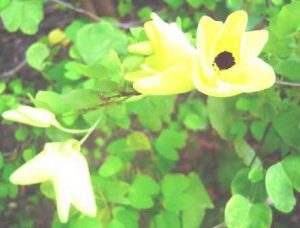
Bauhinia tomentosa. Photo: Bart Wursten. Source: Flora of Zimbabwe
Wandering across to the “Lowveld” section our topic of conversation halted as a tiny yellow spider hanging tenaciously to a piece of its web floated past on the wind and into the distance. It would have been interesting to see where it ended its travels. The lowveld species ranged from Bauhinia tomentosa to several Marula (Sclerocarya birrea). During a moment’s pause next to an Acacia erioloba, Phil recounted a story of a lion attacking a giraffe feeding on one of these trees and in misjudging its attack path impaled itself on the thorns and subsequently died – painful. Several A.xanthophloea with their fever green trunks flourished in an out of range environment while a Cardiogyne africana found its new home with a half drum surround, a most suitable equivalent to its lilting of hot, low altitude areas.
Returning to the house at the end of a most interesting afternoon a Ziziphus mauritiana next to the gate raised some comment about the production of “kachasu” from its fruit. John was, however, reticent about setting up a rural distillery!
At the house Lilian had laid on a lavish tea and, for those who did not wish to venture into the kopje, a video of the 1993 Chelsea Flower Show was screened.
Many thanks John and Lilian for your hospitality and for a most enjoyable day.
-Andy Macnaughtan
BOTANIC GARDEN WALK : 3 JULY 1993
A somewhat hardy group of people met in chilly conditions on this Saturday morning. By general consent, it was agreed that we would continue last month’s topic by looking at plants of the lowveld.
Our first species was Pterocarpus lucens, which was discussed in Phil’s write-up in June. Tom mentioned that trees of hot areas grown in the Botanic Gardens and which therefore encounter abnormal cold when young often respond to this by becoming multi-trunked. ‘
Close by was a large tree with milky sap, a member of the fig family. This was Milicia excelsa which in Zimbabwe occurs only in two places – one is in the Gona-re-Zhou area where a handful of trees grow near the Runde River; the other is near the Haroni /Rusitu confluence, also at low altitudes. This species has male and female flowers on separate trees and Tom has successfully grown trees of both sexes and ripe fruit have been produced by the female trees.
On next to two trees commonly encountered in the lowveld and which are in many ways characteristic of it. The first was Acacia tortilis an invading species, which is part of the early succession colonising areas which have been disturbed, for example because of elephant damage or after cultivation. This species has both hooked and straight thorns and a spirally twisted pod.
The next was Acacia nigrescens which is characteristic of the lowveld, occurring in Jesse bush, Mopane woodland and other habitats. This is an Acacia with hooked thorns and relatively few, large leaflets. Species with similar large leaflets are Acacia goetzei and A.mellifera.
An unknown tree puzzled us for a while Diospyros senensis. Tom remarked how Diospyros species always have little leaves amongst the normal sized ones on their branches. Even Diospyros natalensis which has very small leaves anyway does this, as also does D.whyteana a forest species. This particular specimen was multi- trunked and each trunk was fluted and also had sharp projections on the trunk.
Strange wooden peg-like projections on the stem of Combretum mossambicense were examined. These are leaf-stalks (petioles) which have developed after the leaves have fallen and help to support this climbing shrub.
A plant which was new to me was a member of the RUBIACEAE. It was a shrub called Feretia aeruginescens, which grows on alluvium at low altitudes and which bears fruit directly on the stem. At this stage of the year it also had green leaves turning red and looked a very attractive garden subject.
Once again, our thanks go to Tom for sharing his knowledge with us.
-Mark Hyde
. . . THE PLANTING OF NON-INDIGENOUS TREES LIKE GUMS . . . “The Other Side of the Coin
The report on the Annual General Meeting of the Tree Society of Zimbabwe, as recorded in TREE LIFE No. 160 (June 1993), mentioned a question that was asked “about the severe destruction of woodland to make way for the planting of non- indigenous trees like gums”. The question, and the discussion that followed, raised issues that need to be looked at with more dispassion than I found in the report.
I was not at the AGM, and as a very new member of the Tree-Society I hope to avoid treading on the sensitivities of others, but my business has been trees for more than forty years and I would like to comment, provocatively perhaps, on the question of removing indigenous trees to plant exotics, particularly eucalypts.
The question of eucalypt plantations is one that arouses strong feelings, both for and against; and the arguments used by both the opponents and the supporters of eucalypts have often been based more on prejudice than on a balanced consideration of the facts (verbatim from FAQ 1985: The ecological effects of eucalypts).
There are few who take up cudgels when indigenous woodland is cleared to make way for exotic agricultural crops — maize, tobacco, wheat, soya bean, sugar cane, potatoes, and a host of others – or even for exotic fruit-producing tree crops such as citrus, mango, banana, avocado, papaya. Such activities are regarded as legitimate use of the land. But there is often a furore when indigenous woodland is cleared to make way for exotic wood producing tree crops, especially eucalypts. Is this not a case of double standards?
Up/wards of 70% of Zimbabwe’s population has to rely on wood for cooking and heating, and our indigenous woodlands cannot sustain the demands that are made on them for fuel. At best they might grow at the rate of half a cubic metre per hectare per annum, but plantations of eucalypts in the general conditions of the Mashonaland highveld will produce 30 times that volume from a hectare of land. If indigenous woodland is cut over for fuel, it may be 20-40 years before any coppice regrowth can be cut over again. Eucalypts will sustain coppicing for poles and fuel every 5-8 years for at least three, possibly five, fellings before the stand needs replanting.
It should be clear, then, that even if it means sacrificing some indigenous woodland to establish plantations of fast-growing exotics, it is these very exotics that will reduce the amount of indigenous woodland out each year by providing alternative – and easily renewable sources of wood.
Next to food and clothing wood is one of the most fundamental commodities used by man, particularly rural man, and one would hope that, rather than oppose plantations of exotic trees, the Tree Society would encourage them so as to take the pressure off what remains of out indigenous woodland. I hope I will cause no offence by cautioning against the narrow exclusivity of an Indigenous-Tree Society.
L.J. MULLIN
NYARUPINDA CATCHMENT – July 1993 ~
The Scene: There is a new look in the catchment, one tributary is flowing to replenish the supply in the Nyarupinda dam which is used for irrigation. This has been engined from a dam on the Mutorashanga river more than 10 km away. The flow began in mid June. A short distance from this house there is a settling pool, water gauge and V—notch, the sight and sound of the stream is as pleasing as the knowledge that the dam should never again become empty. Frogs have reacted to the new regime, they are active despite the cold nights and croak as if Jesus has brought the rain (so said the village people). Other responses to the change in environment are expected.
The Civetries : The tree seedlings have died at all three of the civet dung heaps. These sites were abandoned during the rains. Use of two of them began again recently, the one adjacent to a maize land contains mealie pips and seeds which resemble donkey berries Grewia monticola is predominant here, green fruit on drooping branches is there for the taking. The vlei edge midden also contains these small berries, fig seeds, wads of fur and wads of grass.
Darwendale : A souvenir of a recent tree walk with Trevor Gordon was a bagnest made by a gregarious caterpillar of the family of processions:-y moths. Their conspicuous oval nests, sometimes 30cm long hung from Senna singueana and were a comnon sight in the Darwendale area; only very small nests holding less than a dozen cocoons have been found in this catchment. The souvenir was a tough woven bag containing larval droppings, called frass, surrounding hundreds of empty cocoons each with a small circular hole, too small for the emerged adult? Every nest was an impressive edifice and worthy of a photograph.
Thanks to Caroline MacNaughtan for the explanation of ‘to touch wood’. The religious explanation although incorrect was plausible because of the veneration accorded to the cross of Christ.
Anastomosing Bark a diagnostic feature of trees.
Is tree bark with a latticed or interlaced pattern of ridges and furrow. Examples which spring to mind are as follows : Acacia nilotica, Bridelia cathartica, Terminalia spp., Vitex payos and young trees of Parinari curatellifolia, in older ones the lattice is fractured but still discernible. All these make handsome wood samples in the round.
July 11th : There was a morning walk on the hillside with Meg Coates Palgrave at the Ayrshire Club Boating Site at Mazvikadei Dam. She showed us the labels which trees have that indicate how they are recognised. Our eyes became a little bit sharper as they focussed on the venation of leaves of Ficus, Strychnos, Gardenia, Ochna, Faurea and many more. The stalked gland on the bipinnate leaf of Dichrostachys cinerea tested our powers of observation, this feature is easily overlooked because this tree is identified by its flowers, contorted fruits and spine tipped lateral branches and absence of prickles. Meg stressed the fact that all the senses are used in the identification of plants. Thank you Meg.
Mrs Ade asked a question about salt plants and Stephen Mavi provided the following information. The ash of the following trees is used to give food a salty flavour, ‘murunganunyu is the group name for these species. They are Antidesma venosum (tassel berry, which we found on Tennessee Ranch near the Mazvikadei Dam on a previous occasion), Kigelia africana and Rhus tenuinervis. To make salt the wood ash is thoroughly mixed with water and drained very slowly in a strainer which only has a few narrow diameter holes, the brine is collected and evaporated leaving the salt. Sometimes archaeologists have found fragments of strainers used for leaching salty ash, a good reason to look carefully at scatters of potsherds.
-Benedicta Graves
CHIRAWANOO FARM – 18TH JULY 1993
Meeting on the lawn at Chirawanoo farm overlooking a sizeable part of the area, Tony Tree suggested a nearby kopje would be worth a visit prior to having a wander in the dam environs. A convoy of vehicles formed rapidly and we headed off to the kopje a couple of kms away.
Winter had taken its toll of the vegetation as large numbers of trees appeared lifeless, however, subtle hints here and there made identification reasonably easy. Lannea discolor with E.T. fingers and Euphorbia matabelensis with yellow buds on eye level were among the first trees investigated while a smooth, grey barked plant was a Pouzolzia mixta a cluster of dry leaves with white undersides providing the clue.
Evidently the winter had little effect on a group of Diospyros natalensis, their vivid green coloured circular leaves being enhanced by the low level cloud. Pausing next to a Paydrax livida Phil explained that the word “livida” probably referred to its colour – no angry thorns on this one! Another, interesting feature, this time with a Faurea saligna was the submarginal vein running around the leaf margin being more visible than usual, possibly due to the dry nature of the leaf.
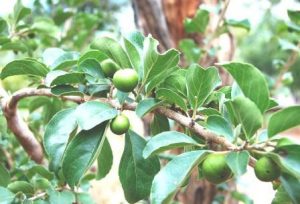
Flacourtia indica. Photo: Bart Wursten. Source: Flora of Zimbabwe
Bright splashes of colour occurred every so often with Flacourtia indica displaying red and purple foliage and Vangueriopsis lanciflora foliage turning to a golden yellow. A strange entwined pair in a thicket turned out to be a white trunked Strychnos innocua and some Pouzolzia mixta clustered below several large Zahna africana. Although not particularly high, the kopje had several enormous boulders with angled faces designed to make a normal ascent difficult. At the top of one of these rocks, Kenneth Haxen managed to lose one of his shoes in a crevice and some one was sent in to retrieve it. Rolls of paper bark peeling from a Commiphora marlothii and a very fluted C. mollis were the sentinels at the summit and in a pocket of loose soil a very hairy Ficus glumosa was starting the age old practice of rock splitting. Near the fig several bits of broken pottery lay scattered about but were probably recent additions as no pattern was evident on the pieces.
At midday we all reassembled and with Tony leading the way the convoy of vehicles headed to the dam passing several groves of Acacia goetzii subsp. goetzii and what appeared to be A. amythethophylla in fruit. A quartzite ridge some distance from the lunch spot looked like an interesting area for an afternoon walk. Our sandwiches must have been a signal to a Giant Kingfisher who swooped on its prey and proceeded to swallow it whole once in the safety of a Brachystegia boehmii.
Keeping out of the chilly breeze meant much wandering in and out of thickets. In one of these tangles cum termite mounds a fruiting Ormocarpum kirkii brought our eyes close to the red flower of a Cadaba termitaria. Only a few flowers could be found and so left reluctantly, as we wandered up the stony ridge. Some excitement at the top of the ridge rekindled interest and we hurried over to see the “find.” A group of Ochna gambleoides grew in the vicinity and the most distinguishing features were the pale blue/green, thick alternate leaves. The typical ochna midrib was present but thick and yellow on both sides of the leaf. A faint layer of a waxy substance (“Like Maytenus undata seen earlier was also visible. Some nearby O.schweinfurthiana looked insignificant when compared to this leaf of heavy duty proportions. A long petiole and a stubby growing tip were the main features noted when a piece of Uapaca nitida was produced by Maureen. Further along the road over the ridge several Aloe chabaudii and A.christianii were seen as well as an interesting hybrid of the two displaying features of both parent plants in its leaf structure.
An almost Commiphora like trunk, succulent, white and peeling, near the road was worth investigating. However, on the branch extremities small purple buds indicated that the tree was in fact Steganotaenia araliacea – a member of the carrot family. A swallow tailed flycatcher was noticed by Sybil, darting about in pursuit of prey while tie rest of us watched our feet as we wandered down the ridge back to the car park.
Despite being cold and cloudy it was a most enjoyable day. Many thanks to our hosts Tom and Maggie Tree for showing us around the kopje and dam. ,
-Andy Macnaughtan
FOOTNOTE : On the Kopje at Chirawanoo, great interest was focussed on two plants. One a creeper with distinctive and attractive dry papery ‘dinglies’, later identified by Bob Drummond as being the seed of the creeper with long white morning glory flowers which fascinated us at Msasa farm in March. This is Turbina stenosiphon. The other a puzzling, scruffy shrub resembling Tricalysia but without the buds, was identified as Jasminum stenolobum. Thank you Dick for satisfying our curiosity.
ANDY MACNAUGHTAN CHAIRMAN


